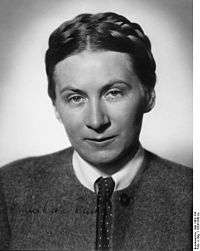Gertrud Scholtz-Klink
| Gertrud Scholtz-Klink | |
|---|---|
|
Gertrud Scholtz-Klink, 1934 | |
| Born |
Gertrud Scholz-Treusch 9 February 1902 Adelsheim, Baden |
| Died |
24 March 1999 (aged 97) Tübingen-Bebenhausen |
| Nationality | German |
| Citizenship | German |
| Known for | Fervent Nazi and supporter of National Socialism |
| Notable work | Die Frau im Dritten Reich (The Woman in the Third Reich, 1978) |
| Political party | National Socialism |
| Movement | National Socialism |
| Spouse(s) | Eugen Klink (1920-1930), Guenther Scholtz (1932-1938), August Heissmeyer (1940- his death) |
| Children | 6 |
Gertrud Scholtz-Klink later known as Maria Stuckebrock (9 February 1902 – 24 March 1999) was a fervent Nazi Party (NSDAP) member and leader of the National Socialist Women's League (NS-Frauenschaft) in Nazi Germany.
Nazi activities


She married a factory worker at the age of eighteen and had six children before he died.
Scholtz-Klink joined the Nazi Party and by 1929 became leader of the women's section in Berlin. In 1932, Scholtz-Klink married Guenther Scholtz, a country doctor (divorced in 1938).
When Adolf Hitler came to power in 1933, he appointed Scholtz-Klink as Reich's Women's Führerin and head of the Nazi Women's League. A good orator, her main task was to promote male superiority, the joys of home labour and the importance of child-bearing.[1] In one speech, she pointed out that "the mission of woman is to minister in the home and in her profession to the needs of life from the first to last moment of man's existence."[2]
Despite her own position, Scholtz-Klink spoke against the participation of women in politics, and took the female politicians in Germany of the Weimar Republic as a bad example: "Anyone who has seen the Communist and Social Democratic women scream on the street and in the parliament, will realize that such an activity is not something which is done by a true woman".[3] She claimed that for a woman to be involved in politics, she would have to "become like a man" to achieve something, which would "shame her sex" - or "behave like a woman", which would prevent her from achieving anything: either way, therefore, nothing was gained from women acting as politicians. [4]
In July 1936, Scholtz-Klink was appointed as head of the Woman's Bureau in the German Labor Front, with the responsibility of persuading women to work for the benefit of the Nazi government. In 1938, she argued that "the German woman must work and work, physically and mentally she must renounce luxury and pleasure", though she herself enjoyed a comfortable material existence.[5]
Scholtz-Klink was usually left out of the more important meetings in the male-dominated society of the Third Reich, and was considered to be a figurehead. For propaganda reasons, Nazi Germany liked to present her as influential to foreign countries, but her own views were reportedly not considered important.[6] She did, however, have the influence over women in the party as Hitler had over everyone else.
By 1940, Scholtz-Klink was married to her third husband SS-Obergruppenführer August Heissmeyer, and made frequent trips to visit women at Political Concentration Camps.
Post-war life
At the end of World War II Scholtz-Klink and Heissmeyer fled from the Battle of Berlin. After the fall of the Third Reich, in the summer of 1945, she was briefly detained in a Soviet prisoner of war camp near Magdeburg, but escaped shortly after. With the assistance of Princess Pauline of Württemberg, she and her third husband went into hiding in Bebenhausen near Tübingen. They spent the subsequent three years under the aliases of Heinrich and Maria Stuckebrock.
On 28 February 1948, the couple were identified and arrested. A French military court sentenced Scholtz-Klink to 18 months in prison on the charge of forging documents.
In May 1950, a review of her sentence classified her as the "main culprit" and sentenced her to additional 30 months. In addition, the court imposed a fine and banned her from political and trade union activity, journalism and teaching for ten years.
After her release from prison in 1953, Sholtz-Klink settled back in Bebenhausen.
In her 1978 book Die Frau im Dritten Reich ("The Woman in the Third Reich"), Scholtz-Klink demonstrated her continuing support for the National Socialist ideology. She once again upheld her position on National Socialism in her interview with historian Claudia Koonz in the early 1980s.[7]
She died on 24 March 1999 in Bebenhausen, Germany.
Publications
- Scholtz-Klink, Gertrud (1978). Die Frau im Dritten Reich. Tübingen: Grabert. (German)
- Scholtz-Klink, Gertrud Über die Stellung der Frau im nationalsozialistischen Deutschland, Herbst 1939
- Waldeck, Countess. "The Girls Did Well by Hitler." Saturday Evening Post. 11 Jul 1942: 14-60. Print.
- Wistrich, Robert S. Who's Who In Nazi Germany. New York: Routledge, 2001.
References
- ↑ Robert Wistrich, Who's Who in Nazi Germany (New York: Routledge, 2001), p. 228.
- ↑ Sigmund, Anna Maria, Nazisternas kvinnor [Nazi Women], Tiedlund, Lund, 2001 (Swedish)
- ↑ Sigmund, Anna Maria, Nazisternas kvinnor [Nazi Women], Tiedlund, Lund, 2001 (Swedish)
- ↑ Sigmund, Anna Maria, Nazisternas kvinnor [Nazi Women], Tiedlund, Lund, 2001 (Swedish)
- ↑ Sigmund, Anna Maria, Nazisternas kvinnor [Nazi Women], Tiedlund, Lund, 2001 (Swedish)
- ↑ Sigmund, Anna Maria, Nazisternas kvinnor [Nazi Women], Tiedlund, Lund, 2001 (Swedish)
- ↑ Koonz, Claudia (1986). Mothers in the Fatherland: Women, the Family, and Nazi Politics.
Further reading
- Livi, Massimiliano (2005). Gertrud Scholtz-Klink: Die Reichsfrauenführerin. Münster: Lit-Verlag. ISBN 978-3-8258-8376-8 (German)
- Sigmund, Anna (2001). Nazisternas kvinnor ("Nazi Women") (Swedish)
